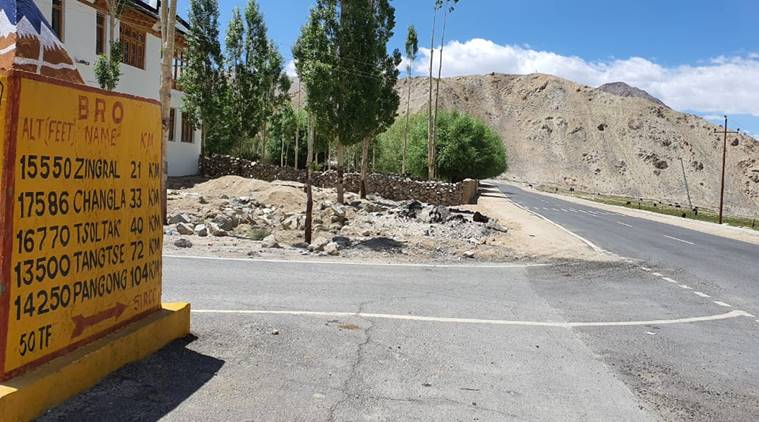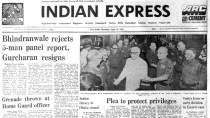- India
- International
Way to Depsang or Doklam?
The ‘no troops land’ (akin to a no man’s land) may lead to peace and tranquillity on the border, but it will not resolve the border question. It is obvious that some kind of buffer zone is being created.
 Four-pillar approach got approval after Doval briefed PM Modi on Wang talks. (Express photo by Varinder Bhatia)
Four-pillar approach got approval after Doval briefed PM Modi on Wang talks. (Express photo by Varinder Bhatia)
The mystery is unravelling. Last week I had written that on October 12, 2019, at Mahabalipuram “Mr Xi seems to have accurately assessed India’s weakened position as a result of the rapidly sliding economy. Mr Modi seems to have totally failed to read Mr Xi’s intentions.” The Indian delegation seems to have basked in the glory of the Mahabalipuram sunshine and designated 2020 as the ‘Year of India-China Cultural and People to People Exchanges’. Later, on December 21, the bonhomie continued at the meeting between the Special Representatives of the two countries.
It is now revealed that Mr Xi had signed in January 2020 a new Training Mobilisation Order (TMO) (see The Hindu, July 13) and, following that
Order, the PLA started planning, mobilisation and movement of troops on their side of the India-China LAC. Another report (see The Indian Express, July 15) quoted an intelligence official who said that the first intelligence reports on Chinese troop movement were available in mid-April, 2020.
Questions Need Answers
Several questions arise:
– Were the MEA and the Army HQ not aware of the new TMO?
– Did Army Intelligence and the R&AW not detect the mobilisation of forces on the China side of the LAC?

– Did our satellites not capture images of the movement of Chinese vehicles and troops toward the LAC at several points along the 200-km stretch between Galwan Valley and Pangong Tso?
– Were the intelligence reports of mid-April not analysed, shared at the highest levels and conclusions drawn?
These are questions which must be answered, not now, but in due course.
Both countries are now engaged in ‘disengagement’ and ‘de-escalation’. That is good in itself, and I support the exercise. Wars have never solved border disputes. A war between India and China, despite the exhortation of TV anchor-generals, is not an option. It is gratifying that the Prime Minister has recognised that truth. However, it is not clear if
Mr Xi also believes that ‘war is not an option’. It is just possible that the PLA has convinced Mr Xi that a limited war-like thrust into India is a viable option and the PLA could take ‘two steps forward and one step backward’.
There are two examples from the recent past: Depsang (2013) and Doklam (2017). The Chinese vacated the intrusion into Depsang completely, but in Doklam, according to Mr Shivshankar Menon, former NSA, “this started with Doklam, where we negotiated withdrawals by both sides from the face-off point in 2017. The Chinese then proceeded to establish a very strong, permanent presence on the plateau, leaving the face-off point itself free.”
Mr Menon called out the government on Doklam and said, “So, frankly, China learned the lesson that as long as the Indian government could walk away with a propaganda victory, they could actually make gains and change the outcomes on the ground in their favour.” Six days after the interview (July 13), the government has not explained the actual situation on the ground in Doklam. Have the Chinese established a strong, permanent presence on the plateau in Doklam? Is Bhutan silent about the Chinese presence because it is helpless and India will not speak up on behalf of Bhutan? While there are no answers to these questions, the false narrative that was sold is that India repelled the Chinese intrusion in Doklam and that it was a significant ‘victory’ for Mr Modi’s stewardship!
From Where to Where?
The current face-off at multiple places along the LAC could go either the Depsang way or the Doklam way. Before you read further, you should bear in mind that there are two perceptions (or versions) of the LAC — the Chinese perception and the Indian perception. With that vital difference in mind, examine the facts. There is no doubt that both sides are withdrawing. The question is, withdrawing from where to where.
Let’s begin with China. If the Chinese troops had not crossed the LAC, according to their perception, they are withdrawing from their own territory to their own territory. There is no loss of territory. If the Chinese troops had crossed the LAC, according to their perception, they are indeed vacating illegally occupied Indian territory.
India’s position is that our troops never crossed the LAC according to our perception, not even on June 15-16. India has defended the action of Colonel Santosh Babu and his team that objected to structures on Indian territory that had been agreed to be removed at the Commanders’ level meeting on June 5. So, the unmistakable conclusion is that India is withdrawing from its own territory to its own territory.
How Far Status Quo Ante?
It is common sense that a ‘no troops land’ (akin to a no man’s land) will be created between the new positions of the troops of both sides. This is the land where the LAC lies, whether according to China’s perception or India’s perception. This space may lead to peace and tranquillity on the border, but it will not resolve the border question. It is obvious that some kind of buffer zone is being created.
The creation of the buffer zone is not India’s declared goal of status quo ante as on May 5, 2020. That, at present, seems far away. If India has yielded too much, it may never be achieved. You should watch closely the process and the progress.
EXPRESS OPINION
More Explained
Apr 26: Latest News
- 01
- 02
- 03
- 04
- 05










































